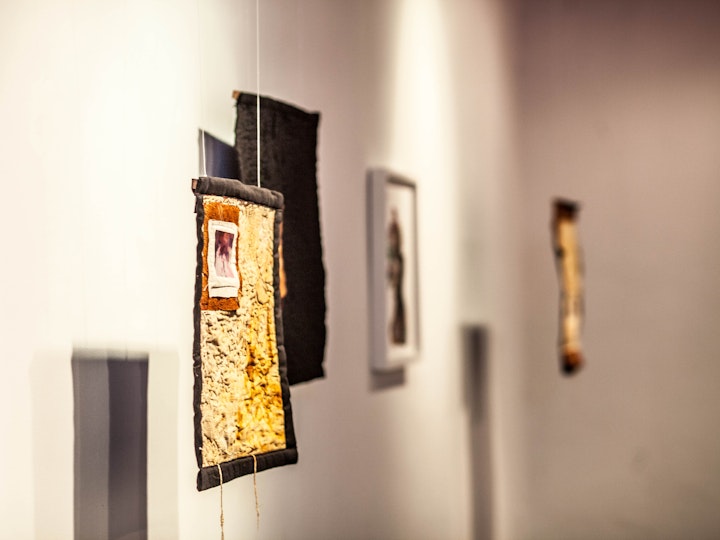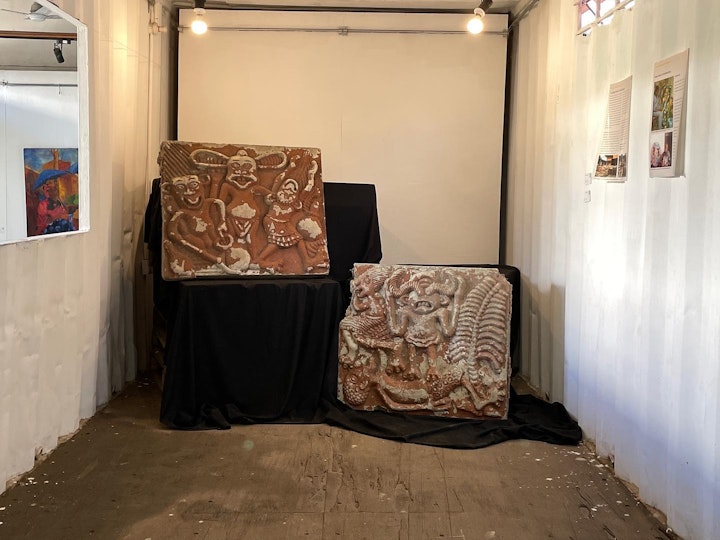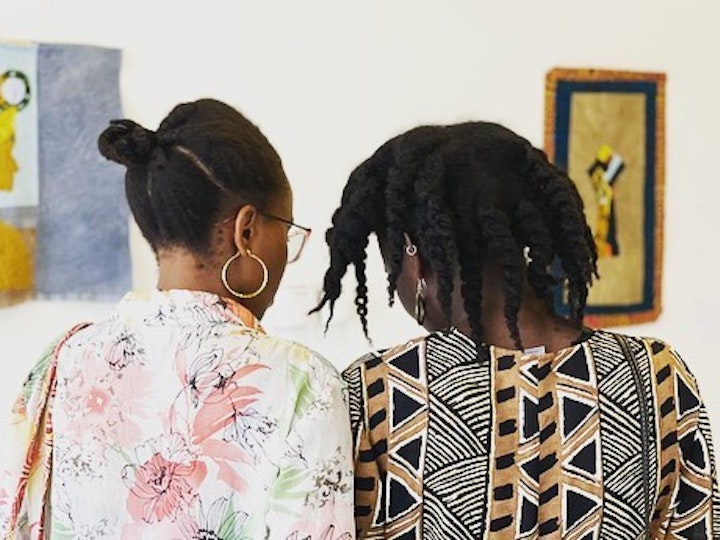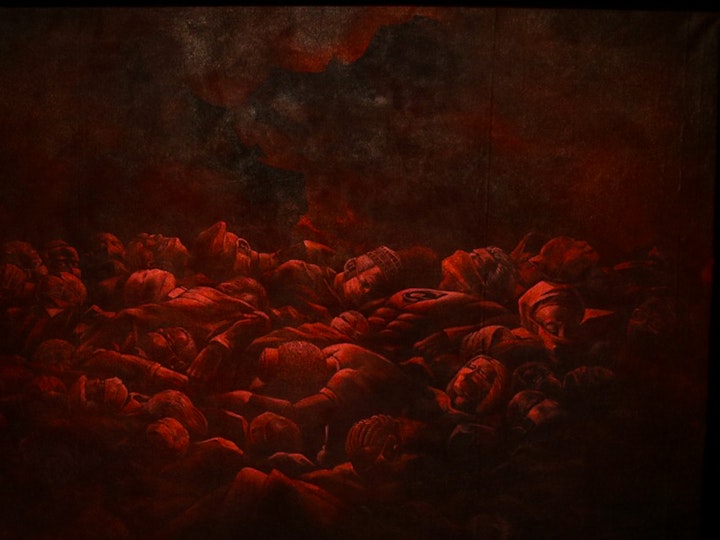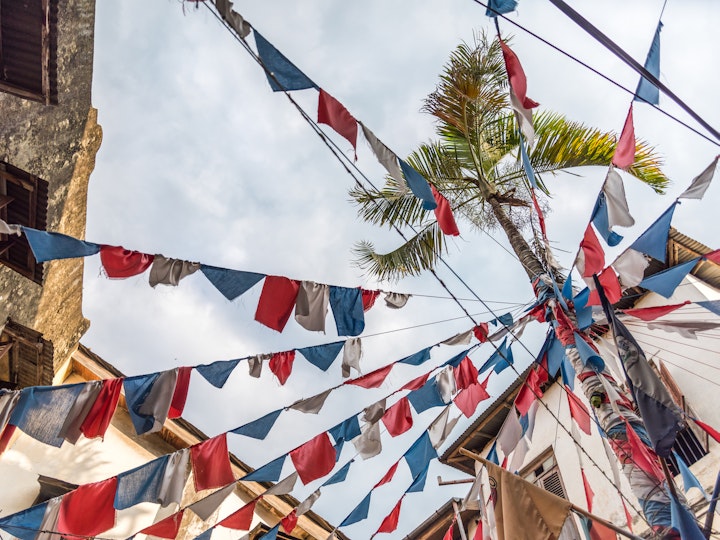rebecca yeong ae mzengi corey

Wonderland
curationWonderland
curation
WONDERLAND
by Mzee Alphonce Saidi Manjonjo
“But I don’t want to go among mad people,” Alice remarked.
“Oh, you can’t help that,” said the Cat.
“We’re all mad here. I’m mad. You’re mad.”
“How do you know I’m mad?” said Alice.
“You must be,” said the Cat, “or you wouldn’t have come here.”
― Lewis Carroll, Alice in Wonderland
“Those works created from solitude and from pure and authentic creative impulses – where the worries of competition, acclaim and social promotion do not interfere – are, because of these very facts, more precious than the productions of professionals…” — Jean Dubuffet, who coined the term “Art Brut” (Raw Art, in French). Art and Text no. 27
Hadithi hadithi… hadithi njoo, uongo njoo, utamu kolea!
Story, story… Come, story. Come, embellishments. Let sweetness gather!
― kiSwahili call-and-response refrain used in Tanzanian oral storytelling
Mzee Alphonce is known for his colourful tales, full of jokes, twists and plot holes big enough for an elephant to pass through. He tells a different version of every story each time he’s asked, always with the same degree of conviction. When asked how he learned to make art, Mzee Alphonce says “Hunger taught me.” No one is entirely sure where he was born, or what his family history is. “Sina watoto, sina mke, sina mchumba, sina nyumba. Lakini nina ubunifu,” he says. “I don’t have children, a wife, a girlfriend, or a house. But I have creativity.”
Just like his stories, Mzee Alphonce’s artworks are hyperbolic and theatrical, embellished with unexpected and sometimes wild details. Mzee Alphonce uses art with a signature blend of humour and irony to magnify the absurdities and contradictions of life as well as global politics. In the same way that the best fantasy tales provide razor-sharp social commentary on the real world, so too do Mzee Alphonce’s whimsical and exaggerated interpretations of fashion, wildlife, and humanity reflect a deep engagement with the world he lives in.
A metal garment with unattached zippers and patterned pants hanging down from it, he says is a “kimini”, a modern girl’s miniskirt, and also a “kibwaya”, or traditional grass skirt. While arguments and judgements abound on what constitutes “real” or authentic African culture, Mzee Alphonce provides a futuristic alternative that claims both modern and ancient identities.
His animal sculptures diverge from the depictions of animals commonly produced for tourist markets. They are one of a kind — he never repeats an animal — and each has a backstory and personality. “Tembo wa Kenya”, for example, is an elephant from Kenya. When asked why he would choose to make a Kenyan elephant rather than a Tanzanian one, he mentions that he is often mistaken for being a Kenyan. So he insists this is a Kenyan elephant, and makes fun of the idea that an animal (or person) would identify itself by national borders when these are often arbitrary or imposed distinctions.
A dunce hat covered in a faded and fraying American flag and a crudely fashioned metal box with a shiny Red Cross hammered on the front are sideways glances at America’s faltering world power and the foreign aid industrial complex. The meanings of these works become more clear when understood in the context of Mzee Alphonce’s close attention to international affairs. His workshop space is filled with newspapers, and he clips out and displays pictures of Donald Trump, Boris Johnson, and Kim Jong Un, perhaps as a reminder of where the true insanity of the world lies.
Because he is old, uneducated, self-taught, and underprivileged, and because he makes art that he rarely sells, Mzee Alphonce is seen by society at large and even other artists as eccentric at best, but most often as mad. Yet as an “outsider” artist who creates art beyond the margins of polite society and an expert-policed industry, his work contains an uninhibited force and immediacy that is unfiltered by either conformity or convention.
“Curiouser and curiouser!” one might exclaim, the more closely they examine Mzee Alphonce’s work. He exposes the fact that indeed, sometimes truth is stranger than fiction. The world we inhabit can be mystifying and bizarre. Sometimes you need to be a bit mad to see.
ARTIST BIOGRAPHY
Alphonce Saidi Manjonjo (b. 1947?), also known as Mzee Alphonce (in kiSwahili, Old Man Alphonce) is an artist practicing at the intersection of installation, sculpture and design. His art, made using recycled tins and spray cans, water bottles, found items, second-hand clothes, and discarded materials, falls under what is called ‘outsider art’ or ‘art brut’ (raw art), which is a term often applied to artists who have not received formal training and whose work possesses simple yet powerful expressions of vision and feeling.
In his earlier life, Mzee Alphonce was a practicing mason, but after a stroke affected the movement of one side of his body, he was unable to continue with his profession. In 2005, a learning programme for elderly people initiated by First Lady Anna Mkapa helped Mzee Alphonce to attend primary school in Dar es Salaam. He attended school for three years but didn’t graduate because a leak of test answers led all results to be nullified. After this, Mzee Alphonce began making art. He collected items around the Mwenge, Dar es Salaam and worked in public along the roadside.In 2013, the artist Poni Yengi saw Mzee Aphonce and brought him to Nafasi Art Space, where previous director Jan Van Esch invited him to work.
His collection of sculptures, hand-painted signs and maps, and newspaper clippings on current events posted on the trees around his makeshift studio have become a living installation that changes and evolves over time. Mzee Alphonce’s work has been exhibited in exhibitions in Tanzania as well as in Germany and has been collected by visitors to Nafasi from around the world.
Nafasi Art Space, Dar es Salaam
October-December 2019











